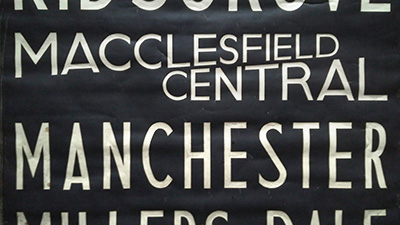Destination Blinds
LMR Stoke & Manchester South Division early 1960s
The blind was produced by Kelbus and is stamped 'BIRMINGHAM A'. Does this differentiate it from 'BIRMINGHAM B', or is this simply the limit of characters available in the stamp and would it otherwise say 'BIRMINGHAM AREA'? It is odd that this blind does not contain many Birmingham destinations.
One theory suggested is that the 'Birmingham' represented the DMU builder the blind was destined for (in this case Birmingham RC&W), the 'A' referring to one of the variants supplied to that builder (depending on what depot / area the vehicles was to be allocated). However another Kelbus blind has been noted with 'Norwich Area' stamped on it, so it seems to define the location rather than the builder.
The blind is marked 50526 and is of a different design to the blinds shown in the photos of 50515 and 50516, which had the same depot allocation. Does this mean it that this blind was an early replacement for an original that was damaged, or was this fitted when the vehicle was transferred from Stoke Cockshute to Newton Heath? The photo of the Class 104 unit on the bottom of Page 52 in the book First Generation DMUs by Kevin Robertson probably shows a vehicle carrying this blind:

Newchapel & Goldenhill and Tunstall stations closed in 1964.
White text on black background, printed on fabric.

Alderley Edge, Macclesfield Central, Stoke-on-Trent and Whaley Bridge are printed in a perspective typeface over two lines, as shown in the image.
Submitted By Greg Scott.
ALDERLEY
EDGE
BIRMINGHAM
BUXTON
CHELFORD
CONGLETON
CRESSWELL
CREWE
DERBY
EXCURSION
HAZEL GROVE
KIDSGROVE
MACCLESFIELD
CENTRAL
MANCHESTER
MILLERS DALE
NEWCHAPEL & G.
SPECIAL
STAFFORD
STALYBRIDGE
STOCKPORT
STOKE
-ON-TRENT
STONE
TUNSTALL
UTTOXETER
WHALEY
BRIDGE
WILMSLOW
WOLVERHAMPTON


